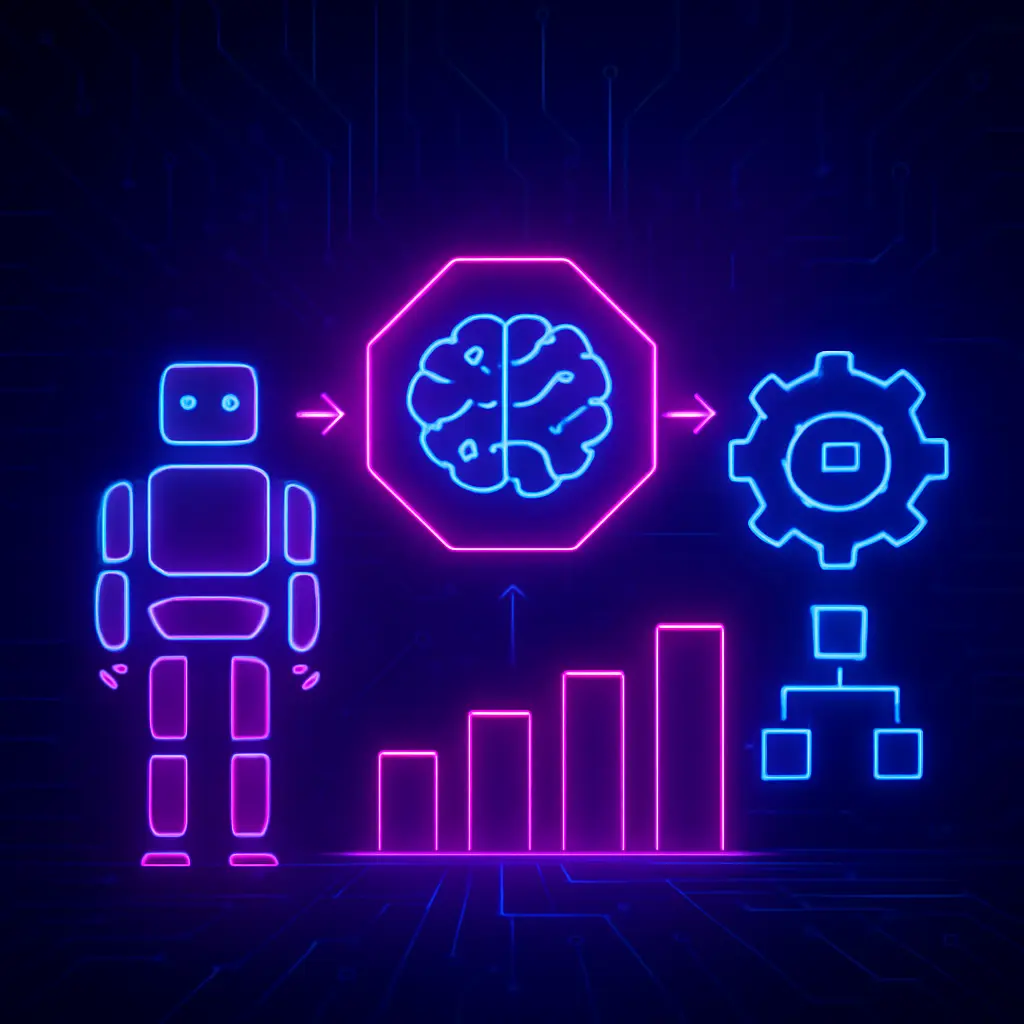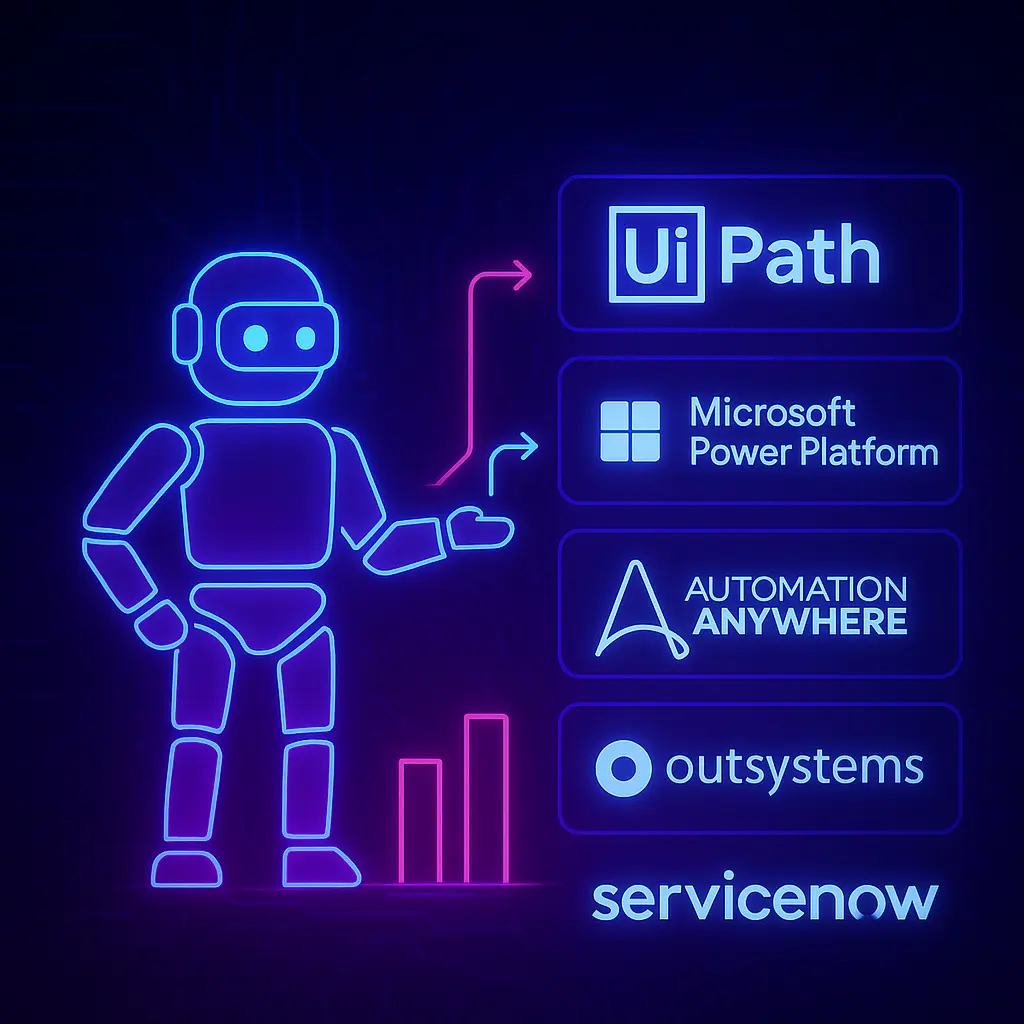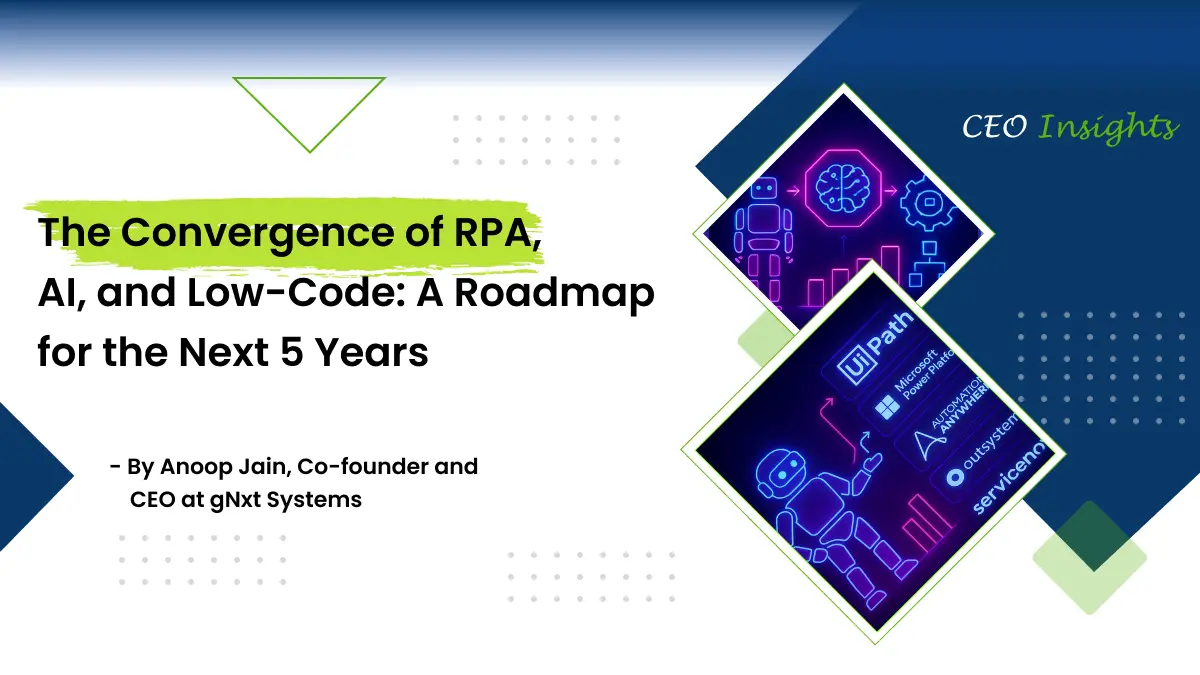- August 14, 2025
- by Anoop Jain
The Convergence of RPA, AI, and Low-Code: A Roadmap for the Next 5 Years
A New Era in Intelligent Automation
Automation is no longer a niche efficiency play—it’s becoming the backbone of enterprise transformation. In the next five years, Robotic Process Automation (RPA), Artificial Intelligence (AI), and Low-Code/No-Code platforms will converge to create adaptive, end-to-end automation ecosystems.
This evolution marks a profound shift: from siloed task automation to holistic, intelligent orchestration. Instead of deploying RPA bots in isolation, enterprises will fuse AI’s decision-making power with the agility of Low-Code development, unlocking scalable, self-optimizing business processes.
The result? Automation that thinks, adapts, and evolves with the business—reducing operational friction, accelerating innovation, and creating a competitive moat.
The Data Driving Convergence

The momentum behind this shift isn’t hypothetical—it’s measurable. Industry research highlights the acceleration:
- RPA: $13.9B market in 2024, forecasted CAGR 23.4% through 2030
- AI in Automation: 50% of enterprises now integrate AI in at least one process, with GenAI adoption doubling annually
- Low-Code/No-Code: Expected to reach $46.4B by 2026, driven by demand for rapid deployment and citizen development
Organizations embracing integrated RPA+AI+Low-Code models have reported:
- 30–50% reduction in process execution costs
- 2–4x faster automation deployment cycles
- 40% decrease in maintenance overhead through unified platforms
These aren’t incremental gains—they represent structural advantage. Integration compounding over time amplifies both efficiency and innovation.
Beyond Efficiency: Redefining the Enterprise Automation Experience
The convergence of RPA, AI, and Low-Code changes not just how automation is built, but who builds it and how quickly it evolves.
- RPA takes on execution—moving data, triggering actions, ensuring process consistency.
- AI becomes the decision layer—interpreting unstructured inputs, predicting outcomes, and personalizing responses.
- Low-Code empowers both technical and business users to rapidly design, deploy, and iterate workflows.
The result is a democratized automation environment where business analysts, operations teams, and IT collaborate in real time. Feedback loops shrink from months to days. Process innovation becomes continuous, not episodic.
Yet, the shift demands governance and discipline:
- AI-driven automations must be transparent and auditable
- Low-Code deployments require enterprise-grade security controls
- RPA bots need resilience to adapt to evolving system landscapes
- RPA takes on execution—moving data, triggering actions, ensuring process consistency.
gNxt Systems: Architecting the Future of Converged Automation
At gNxt Systems, we see the convergence of RPA, AI, and Low-Code as a strategic inflection point.
Our automation philosophy is simple: integrate, orchestrate, and scale with intent. We design automation stacks that don’t just execute tasks—they learn from every interaction and continuously optimize.
Our methodology includes:
- Embedding AI-driven decision layers within RPA workflows
- Leveraging Low-Code to empower rapid iteration without compromising enterprise standards
- Deploying governance frameworks to ensure compliance and transparency at scale
“The next five years won’t be about who has the most bots—it will be about who builds the most adaptive automation ecosystem. RPA, AI, and Low-Code together will be the operating system of the intelligent enterprise.”
— Anoop Jain, CEO, gNxt Systems
Platforms and Tools Leading the Convergence

The ecosystem is rapidly aligning around integrated stacks:
- UiPath + AI Center – Adaptive automation combining ML models with RPA at scale
- Microsoft Power Platform + Copilot – Low-Code app and automation development with embedded GenAI
- Automation Anywhere + AARI – Conversational RPA enabling natural language-driven workflows
- OutSystems – Enterprise-grade Low-Code with RPA connectors and AI optimization
- ServiceNow Creator Workflows – Orchestrating automation within ITSM and enterprise processes
These platforms illustrate the shift from tools to automation operating systems.
What Comes Next
The next five years will see three major breakthroughs in converged automation:
- Autonomous Process Orchestration – Workflows self-configure based on business context
- Industry-Specific Automation Templates – Pre-trained AI+RPA+Low-Code packages for faster deployment
- AI-Governed Compliance – Automated enforcement of security, privacy, and regulatory rules in real time
Organizations that invest early in convergence architectures will benefit from compounding returns—automation that not only scales but adapts faster than competitors can react.
Frequently Asked Questions (FAQ)
It’s the integration of execution (RPA), intelligence (AI), and agility (Low-Code) into a single automation stack.
Not obsolete—evolved. Bots will increasingly be AI-powered and context-aware.
Yes. Low-Code enables business users to create workflows while IT ensures governance.
Enterprises adopting converged automation have reported up to 50% cost savings and 4x faster process deployment.
Read these blogs by gNxt Systems. They might interest you:
Vibe Coding & the AI-Driven Future of App Development
The Future is Agentic: Preparing Enterprises for the Next Wave of AI Evolution
Agentic AI in 2025: The Definitive Guide to Trends, Real-World Impact, and Adoption Data
Conversational AI Agents for Sales, Finance, and HR What’s Possible Today?
Also click this link to checkout Agentic AI Offerings by gNxt Systems
About Author

CEO at gNxt Systems
With 25+ years of expertise, Mr. Anoop Jain delivers complex projects, driving innovation through IT strategies and inspiring teams to achieve milestones in a competitive, technology-driven landscape.


